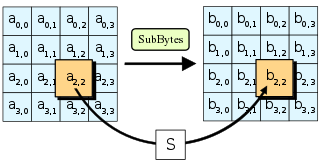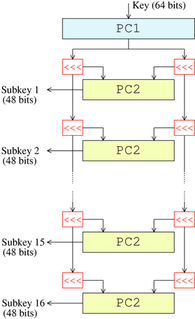History
The original MITM attack was first suggested in an article by Diffie and Hellman in 1977, where they discussed the cryptanalytic properties of DES. [1] They argued that the keysize of DES was too small, and that reapplying DES multiple times with different keys could be a solution to the key-size; however, they advised against using double-DES and suggested triple-DES as a minimum, due to MITM attacks (Double-DES is very susceptible to a MITM attack, as DES could easily be split into two subciphers (the first and second DES encryption) with keys independent of one another, thus allowing for a basic MITM attack that reduces the computational complexity from  to
to  .
.

Bailey Whitfield 'Whit' Diffie, ForMemRS, is an American cryptographer and one of the pioneers of public-key cryptography along with Martin Hellman and Ralph Merkle. Diffie and Hellman's 1976 paper New Directions in Cryptography introduced a radically new method of distributing cryptographic keys, that helped solve key distribution—a fundamental problem in cryptography. Their technique became known as Diffie–Hellman key exchange. The article stimulated the almost immediate public development of a new class of encryption algorithms, the asymmetric key algorithms.

Martin Edward Hellman is an American cryptologist, best known for his invention of public key cryptography in cooperation with Whitfield Diffie and Ralph Merkle. Hellman is a longtime contributor to the computer privacy debate, has applied risk analysis to a potential failure of nuclear deterrence, and in 2016 wrote a book with his wife, Dorothie Hellman, that links creating love at home to bringing peace to the planet.
Many variations has emerged, since Diffie and Hellman suggested MITM attacks. These variations either makes MITM attacks more effective, or allows them to be used in situations, where the basic variant cannot. The 3-subset variant was shown by Bogdanov and Rechberger in 2011, [2] and has shown its use in cryptanalysis of ciphers, such as the lightweight block-cipher family KTANTAN.
Procedure
As with general MITM attacks, the attack is split into two phases: A key-reducing phase and a key-verification phase. In the first phase, the domain of key-candidates is reduced, by applying the MITM attack. In the second phase, the found key-candidates are tested on another plain-/ciphertext pair to filter away the wrong key(s).
Key-reducing phase
In the key-reducing phase, the attacked cipher is split into two subciphers,  and
and  , with each their independent keybits, as is normal with MITM attacks. Instead of having to conform to the limitation that the keybits of the two subciphers should be independent, the 3-subset attack allows for splitting the cipher into two subciphers, where some of the bits are allowed to be used in both of the subciphers.
, with each their independent keybits, as is normal with MITM attacks. Instead of having to conform to the limitation that the keybits of the two subciphers should be independent, the 3-subset attack allows for splitting the cipher into two subciphers, where some of the bits are allowed to be used in both of the subciphers.
This is done by splitting the key into three subsets instead, namely:
 = the keybits the two subciphers have in common.
= the keybits the two subciphers have in common. = the keybits distinct to the first subcipher,
= the keybits distinct to the first subcipher, 
 = the keybits distinct to the second subcipher,
= the keybits distinct to the second subcipher, 
To now carry out the MITM attack, the 3 subsets are bruteforced individually, according to the procedure below:
- For each guess of
 :
: - Calculate the intermediate value
 from the plaintext, for all key-bit combinations in
from the plaintext, for all key-bit combinations in 
- Calculate the intermediate value
 , for all key-bit combinations in
, for all key-bit combinations in 
- Compare
 and
and  . When there is a match. Store it is a key-candidate.
. When there is a match. Store it is a key-candidate.
Key-testing phase
Each key-candidate found in the key-reducing phase, is now tested with another plain-/ciphertext pair. This is done simply by seeing if the encryption of the plaintext, P, yields the known ciphertext, C. Usually only a few other pairs are needed here, which makes the 3-subset MITM attack, have a very little data complexity.
Example
The following example is based on the attack done by Rechberger and Bogdanov on the KTANTAN cipher-family. The naming-conventions used in their paper is also used for this example. The attack reduces the computational complexity of KTANTAN32 to  , down from
, down from  if compared with a bruteforce attack. A computational complexity of
if compared with a bruteforce attack. A computational complexity of  is of 2014 still not practical to break, and the attack is thus not computationally feasible as of now. The same goes for KTANTAN48 and KTANTAN64, which complexities can be seen at the end of the example.
is of 2014 still not practical to break, and the attack is thus not computationally feasible as of now. The same goes for KTANTAN48 and KTANTAN64, which complexities can be seen at the end of the example.
The attack is possible, due to weaknesses exploited in KTANTAN's bit-wise key-schedule. It is applicable to both KTANTAN32, KTANTAN48 and KTANTAN64, since all the variations uses the same key-schedule. It is not applicable to the related KANTAN family of block-ciphers, due to the variations in the key-schedule between KTANTAN and KANTAN.
Overview of KTANTAN
KTANTAN is a lightweight block-cipher, meant for constrained platforms such as RFID tags, where a cryptographic primitive such as AES, would be either impossible (given the hardware) or too expensive to implement. It was invented by Canniere, Dunkelman and Knezevic in 2009. [3] It takes a block size of either 32, 48 or 64 bits, and encrypts it using an 80-bit key over 254 rounds. Each round utilizes two bits of the key (selected by the key schedule) as round key.

The Advanced Encryption Standard (AES), also known by its original name Rijndael, is a specification for the encryption of electronic data established by the U.S. National Institute of Standards and Technology (NIST) in 2001.

In cryptography, the so-called product ciphers are a certain kind of cipher, where the (de-)ciphering of data is typically done as an iteration of rounds. The setup for each round is generally the same, except for round-specific fixed values called a round constant, and round-specific data derived from the cipher key called a round key. A key schedule is an algorithm that calculates all the round keys from the key.
Attack
Preparation
In preparation to the attack, weaknesses in the key schedule of KTANTAN that allows the 3-subset MITM attack was identified. Since only two key-bits are used each round, the diffusion of the key per round is small - the safety lies in the number of rounds. Due to this structure of the key-schedule, it was possible to find a large number of consecutive rounds, which never utilized certain key-bits.
More precisely, the authors of the attack found that:
- Round 1 to 111 never uses the key-bits:

- Round 131 to 254 never uses the key-bits:

This characteristics of the key-schedule is used for staging the 3-subset MITM attack, as we now are able to split the cipher into two blocks with independent key-bits. The parameters for the attack are thus:
 = the keybits used by both blocks (which means the rest 68 bits not mentioned above)
= the keybits used by both blocks (which means the rest 68 bits not mentioned above) = the keybits used only by the first block (defined by round 1-111)
= the keybits used only by the first block (defined by round 1-111) = the keybits used only by the second block (defined by round 131-254)
= the keybits used only by the second block (defined by round 131-254)
Key-testing phase
KTANTAN32 requires on average 2 pairs now to find the key-candidate, due to the false positives from only matching on part of the state of the intermediate values. KTANTAN48 and KTANTAN64 on average still only requires one plain-/ciphertext pair to test and find the correct key-candidates.
In cryptography, a block cipher is a deterministic algorithm operating on fixed-length groups of bits, called a block, with an unvarying transformation that is specified by a symmetric key. Block ciphers operate as important elementary components in the design of many cryptographic protocols, and are widely used to implement encryption of bulk data.

The Data Encryption Standard is a symmetric-key algorithm for the encryption of electronic data. Although its short key length of 56 bits, criticized from the beginning, makes it too insecure for most current applications, it was highly influential in the advancement of modern cryptography.
Differential cryptanalysis is a general form of cryptanalysis applicable primarily to block ciphers, but also to stream ciphers and cryptographic hash functions. In the broadest sense, it is the study of how differences in information input can affect the resultant difference at the output. In the case of a block cipher, it refers to a set of techniques for tracing differences through the network of transformation, discovering where the cipher exhibits non-random behavior, and exploiting such properties to recover the secret key.
In cryptography, linear cryptanalysis is a general form of cryptanalysis based on finding affine approximations to the action of a cipher. Attacks have been developed for block ciphers and stream ciphers. Linear cryptanalysis is one of the two most widely used attacks on block ciphers; the other being differential cryptanalysis.

In cryptography, ciphertext or cyphertext is the result of encryption performed on plaintext using an algorithm, called a cipher. Ciphertext is also known as encrypted or encoded information because it contains a form of the original plaintext that is unreadable by a human or computer without the proper cipher to decrypt it. Decryption, the inverse of encryption, is the process of turning ciphertext into readable plaintext. Ciphertext is not to be confused with codetext because the latter is a result of a code, not a cipher.

In cryptography, the Tiny Encryption Algorithm (TEA) is a block cipher notable for its simplicity of description and implementation, typically a few lines of code. It was designed by David Wheeler and Roger Needham of the Cambridge Computer Laboratory; it was first presented at the Fast Software Encryption workshop in Leuven in 1994, and first published in the proceedings of that workshop.

In cryptography, DES-X is a variant on the DES symmetric-key block cipher intended to increase the complexity of a brute force attack using a technique called key whitening.
The slide attack is a form of cryptanalysis designed to deal with the prevailing idea that even weak ciphers can become very strong by increasing the number of rounds, which can ward off a differential attack. The slide attack works in such a way as to make the number of rounds in a cipher irrelevant. Rather than looking at the data-randomizing aspects of the block cipher, the slide attack works by analyzing the key schedule and exploiting weaknesses in it to break the cipher. The most common one is the keys repeating in a cyclic manner.
In cryptography, an interpolation attack is a type of cryptanalytic attack against block ciphers.

In cryptography, a one-way compression function is a function that transforms two fixed-length inputs into a fixed-length output. The transformation is "one-way", meaning that it is difficult given a particular output to compute inputs which compress to that output. One-way compression functions are not related to conventional data compression algorithms, which instead can be inverted exactly or approximately to the original data.
The Hasty Pudding Cipher (HPC) is a variable-block-size block cipher designed by Richard Schroeppel, which was an unsuccessful candidate in the competition for selecting the U.S. Advanced Encryption Standard (AES). It has a number of unusual properties for a block cipher: its input block size and key length are variable, and it includes an additional input parameter called the "spice" for use as a secondary, non-secret key. The Hasty Pudding cipher was the only AES candidate designed exclusively by U.S. cryptographers.
In cryptography, M8 is a block cipher designed by Hitachi in 1999. The algorithm negotiates introduced in 1997 M6, with the modified key length, which is enlarged to 64 bits or more. This cipher operates with Feistel network and designed to reach high performance on small implementation or 32 bits devices. For instance, by using round numbers = 10 it present encryption speed at 32 Mbps for dedicated hardware of 6K gates and 25 MHz clock or 208 Mbps for program, that uses C-language and Pentium-I 266MHz. Due to the openness of description, it should not be used in open or multivendor software.
This article summarizes publicly known attacks against block ciphers and stream ciphers. Note that there are perhaps attacks that are not publicly known, and not all entries may be up to date.
The rebound attack is a tool in the cryptanalysis of cryptographic hash functions. The attack was first published in 2009 by Florian Mendel, Christian Rechberger, Martin Schläffer and Søren Thomsen. It was conceived to attack AES like functions such as Whirlpool and Grøstl, but was later shown to also be applicable to other designs such as Keccak, JH and Skein.
A biclique attack is a variant of the meet-in-the-middle (MITM) method of cryptanalysis. It utilizes a biclique structure to extend the number of possibly attacked rounds by the MITM attack. Since biclique cryptanalysis is based on MITM attacks, it is applicable to both block ciphers and (iterated) hash-functions. Biclique attacks are known for having broken both full AES and full IDEA, though only with slight advantage over brute force. It has also been applied to the KASUMI cipher and preimage resistance of the Skein-512 and SHA-2 hash functions.
Partial-matching is a technique that can be used with a MITM attack. Partial-matching is where the intermediate values of the MITM attack,
and
, computed from the plaintext and ciphertext, are matched on only a few select bits, instead of on the complete state.
In cryptography, a known-key distinguishing attack is an attack model against symmetric ciphers, whereby an attacker who knows the key can find a structural property in cipher, where the transformation from plaintext to ciphertext is not random. There is no common formal definition for what such a transformation may be. The chosen-key distinguishing attack is strongly related, where the attacker can choose a key to introduce such transformations.
Prince is a block cipher targeting low latency, unrolled hardware implementations. It is based on the so-called FX construction. Its most notable feature is the "alpha reflection": the decryption is the encryption with a related key which is very cheap to compute. Unlike most other "lightweight" ciphers, it has a small number of rounds and the layers constituting a round have low logic depth. As a result, fully unrolled implementation are able to reach much higher frequencies than AES or PRESENT. According to the authors, for the same time constraints and technologies, PRINCE uses 6-7 times less area than PRESENT-80 and 14-15 times less area than AES-128.



























